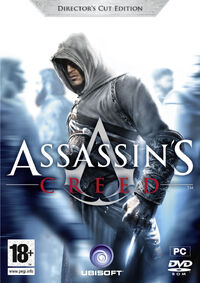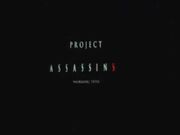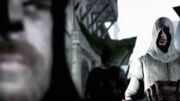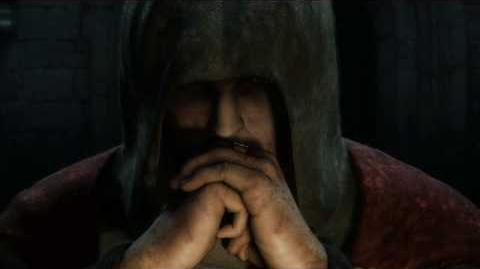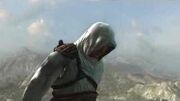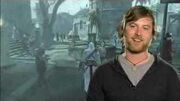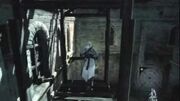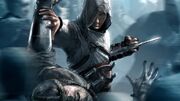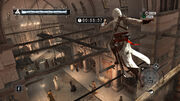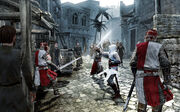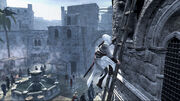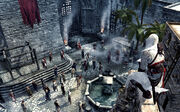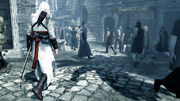| This article is about the first video game in the series. You may be looking for Assassin's Creed (series). |
- "Jerusalem, the twelfth century. Amidst the chaos of the Third Crusade, a Brotherhood of warriors rose to power. Shrouded in secrecy, feared for their ruthlessness, they alone would save the Holy Land, or destroy it. They were the Assassins."
- ―Assassin's Creed pre-E3 2006 Trailer.
Assassin's Creed is a sandbox style action-adventure-stealth video game developed by Ubisoft Montreal and published by Ubisoft. The game was released for the Xbox 360 and PlayStation 3 in November 2007 and for PC in April 2008.
The game centers around the use of a machine dubbed the "Animus", which allows its user to view the genetic memories of their ancestors. The protagonist is a bartender named Desmond Miles, who is abducted by the company Abstergo Industries and forced to relive the memories of his ancestor Altaïr Ibn-La'Ahad, an Assassin. As Desmond explores Altaïr's story in the Holy Land during the Third Crusade, details of a battle between two ancient sects—the Knights Templar and the Assassin Order—emerge as both scour for artifacts known only as "Pieces of Eden."
Assassin's Creed received primarily positive reviews, for both its story and its gameplay, and received several awards at 2006's E3. In November 2009, a sequel in the form of Assassin's Creed II was released, building on the foundation set by Assassin's Creed.
Gameplay
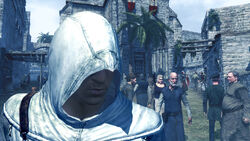
Altaïr Ibn-La'Ahad, one of the game's protagonists
Assassin's Creed is a non-linear action-adventure video game, during which the player controls the 12th-century Levantine Assassin Altaïr Ibn-La'Ahad, whose life during the Third Crusade is experienced through the Animus by his 21st century descendant, Desmond Miles. The game's overall goal is to rise through the Assassins' ranks by carrying out a series of assassinations given by the Order's leader, Al Mualim. In doing so, Altaïr travels from Masyaf to cities in the Holy Land, specifically, Jerusalem, Acre, and Damascus.
Upon arrival in any of the cities, Altaïr must locate an Assassin bureau and discuss his tasks with the local rafiq, a Brotherhood agent, gaining basic knowledge of his target. From there, it is up to Altaïr to perform additional reconnaissance via eavesdropping, interrogations, meeting with informers, and gathering important items. It is only after Altaïr has gathered enough information that he can carry out the assassination. After successfully completing an assassination, Altaïr returns to Masyaf to debrief with Al Mualim, and is subsequently rewarded with better equipment, before he is given the names of his next targets.
Between main memories, Desmond must direct Altaïr to high points in the city to further synchronize his surroundings and map out the city that Altaïr is currently located in. Other side memories include tracking and killing Templars, collecting flags, and saving Civilians who are being threatened by city guards.
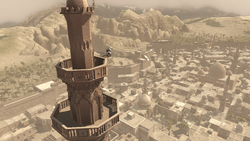
High vantage points allow the player to map out portions of the city
Accompanying this, Altaïr needs to carry out most of his actions without being noticed by officials. The game uses a meter dependent on social stealth to inform the player of how noticeable Altaïr is to surrounding individuals, including the guards, by changing the color and shape of the Abstergo logo; performing certain actions at certain times may or may not raise the local area's awareness level. If an area is on high alert, indicated by the logo becoming red and the entire synchronization interface earning a red tinge and background, guards will be always vigilant and citizens will scatter in various directions in the event that the guards chase and attempt to bring down Altaïr. To reduce his notoriety, Altaïr must break the guards' line of sight and then find a hiding place, blend in with wandering scholars, or join citizens sitting on benches.
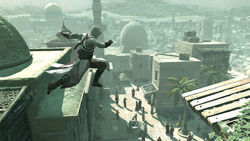
Altaïr's freerunning abilities allow for greater exploration
To conduct many of the assassinations and various other tasks, Altaïr is capable of both high and low profile commands, both of which affect the alertness level. Low profile commands will allow Altaïr to blend into crowds, hide, and use Altaïr's Hidden Blade to attempt quiet and low profile assassinations. High profile commands increase alertness at a greater level and include freerunning, attacking foes, and high profile assassination attempts. In the event that the player finds themself faced with multiple enemies, one can utilize Altaïr's sword-fighting abilities to combat guards.
Health in Assassin's Creed is measured as the level of synchronization between Desmond and Altaïr's memories. Whenever Altaïr is injured, it is experienced as a deviation from the actual memory that occurred and synchronization decreases. If there is complete desynchronization, the current memory that Desmond is experiencing dematerializes and restarts at the last stable checkpoint.
Because Altaïr's memories are rendered by the Animus software, "glitches" may often be experienced with nucleotides and error messages appearing. These glitches can be used to help identify targets and if the player reacts quickly enough, may be used to provide other vantage points during cut-scenes.
Synopsis
Setting
Desmond Miles, a seemingly ordinary bartender, is kidnapped by the company Abstergo Industries for use as a test subject in the Animus, a device that can simulate genetic memory. Abstergo intends to put Desmond in the device to relive the memories of his ancestor Altaïr Ibn-La'Ahad, a member of the Assassin Brotherhood who lived during the Third Crusade in the Holy Land. Initially, Desmond has trouble adjusting to the device, but eventually relives Altaïr's exploits over the next several days. The game then primarily changes to Altaïr's point-of-view, with occasional transitions to Desmond, due to problems with the Animus or onset of the Bleeding Effect.
Plot
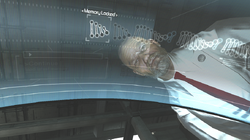
Warren Vidic of Abstergo Industries overlooks Desmond inside the Animus
The game opens with Desmond entering Altaïr's memory, but he soon faces synchronization problems. On this, Lucy Stillman and Warren Vidic's voices can be heard, arguing over Desmond's safety within the Animus. After experiencing a few problems, Desmond exits the virtual machine and Vidic briefs him about the Animus' inner workings, before initializing the machine's tutorial program. After Desmond is done with the tutorial, he enters Altaïr's closest memory that he can synchronize with; Lucy adds that Desmond has to relive key moments of Altaïr's life to increase his synchronization, before reaching the final memory which holds the information that Abstergo is seeking.
In 1191, Altaïr attempts to retrieve one of a series of artifacts known as the "Pieces of Eden" from Solomon's Temple alongside two fellow Assassins, Malik Al-Sayf and his brother Kadar. However, the trio are beaten to the treasure by Robert de Sablé, Grand Master of the Knights Templar and the Assassins' sworn enemy. While attempting to recover the treasure from the Templars and kill Robert, Altaïr breaks all three tenets of the Assassins' Creed and is forced to escape empty-handed after being overpowered by Robert. In the following battle, Kadar is killed and Malik's left arm is crippled and later amputated. When Altaïr returns to the Assassins' stronghold at Masyaf with apologies, Malik, who survived the Templars' attack, comes back with the artifact and disparages Altaïr because of his arrogance.
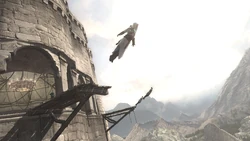
Altaïr, Rauf and another Assassin performing the Leap of Faith
After narrowly defeating a retaliatory attack by the Templars, the Assassins' leader Al Mualim demotes Altaïr to a novice but gives him another chance to rise through the Brotherhood's ranks. Al Mualim assigns Altaïr the task of assassinating nine key figures across the Holy Land in Jerusalem, Acre, and Damascus, aiming to bring peace between the Crusader and Saracen forces. Each target is based on an actual historical figure from the Third Crusade.
Altaïr completes each task, learning how each target is connected to Robert and the Templars, and how they all aim to end the Crusades and place the Holy Land under their own control. With men on both sides killed, he discovers that Robert's last plot is to attempt to unite the Christian and Muslim forces against their new common enemy, the Assassins themselves. Altaïr eventually slays Robert before King Richard I of England, ending the Templars' plans but failing to convince the King that an end to the war would be welcome to both sides. From a dying Robert, Altaïr learns that Al Mualim had helped the Templars locate the Piece of Eden in Solomon's Temple but eventually betrayed them, just as he had the Assassins, in order to keep the artifact for himself.
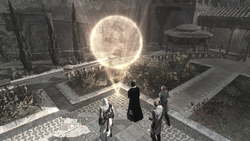
Altaïr discovers a map detailing the locations of other Pieces of Eden
Altaïr quickly returns to Masyaf and confronts his master, who reveals the truth to him: the Piece of Eden is not a supernatural artifact but rather creates illusions. He denounces religion and other seemingly supernatural events (e.g. the Ten Plagues of Egypt, the parting of the Red Sea, and the presence of the Greek Gods in the Trojan War) as illusions caused by the Piece, and then states his intention to use the artifact to compel humanity into a brainwashed state, and in doing so, bringing an end to all conflict. Altaïr is eventually able to see through the deceptions created by the artifact and kill Al Mualim. When Altaïr recovers the artifact, the Piece of Eden activates, showing a holographic view of Earth with the locations of countless other Pieces of Eden marked across the globe.
When the process is complete, Desmond learns that Abstergo is the Templars' modern-day front and that they are already seeking the Pieces of Eden from the locations identified in Altaïr's memories. Furthermore, he learns that the modern-day Assassins tried to rescue him due to him once being an Assassin himself, but failed. Following this, Desmond is to be killed after an order from the high-ranking Templar Alan Rikkin, but Lucy saves him by convincing Rikkin and the others that Desmond can still be useful to them. Before Lucy leaves with Vidic, she indicates to Desmond that she is an undercover Assassin by tucking her ring finger into her palm, referring to the Assassins' tradition of severing their finger in order to join them and operate their signature weapon, the Hidden Blade.
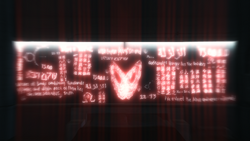
Clay's blood messages in Desmond's room
Though Desmond remains trapped in the Abstergo laboratory, his experience in the Animus has created a Bleeding Effect of Altaïr's life in his own, allowing Desmond to use Altaïr's Eagle Vision, which, in turn, allows him to see strange messages painted on the walls of his room and the floor of the lab. The messages all deal with various forms of the end of the world from different cultures, including several references to 21 December 2012, the date that Abstergo plans to launch a satellite that will "permanently end the war". It is hinted that this method would be by the same method that Al Mualim hypnotized Masyaf, only on a larger scale. The game ends with Desmond wondering what the images all mean and who could have drawn them.
Development
| System requirements | ||||||||||||||||||||||||
|---|---|---|---|---|---|---|---|---|---|---|---|---|---|---|---|---|---|---|---|---|---|---|---|---|
| ||||||||||||||||||||||||
After the 2003 release of Prince of Persia: The Sands of Time, creative director Patrice Désilets developed a spin-off entitled Prince of Persia: Assassin about an Assassin in Jerusalem protecting a prince with magical powers.[1]
The first details on what would become Assassin's Creed came in mid-September 2005 during the Tokyo Game Show, when GameSpot reported on Ubisoft's trailer for a new game in production with the working title of "Project Assassins".[2] No further word was heard until E3 2006, when an updated version of the trailer was shown under the name Assassin's Creed. When GamesRadar pressed Ubisoft for comment after they previously claimed Assassin's Creed had never been previewed before, a representative confirmed that "Project Assassins" and Assassin's Creed were indeed the same.[3]
In a September 2006 interview with IGN, game producer Jade Raymond described Altaïr as a "medieval hitman with a mysterious past" and definitely not a time traveler.[4] In October 2007, in an IGN Australia interview, Patrice Désilets described the lead character's ability to climb and free-run as being designed by the individuals who developed the mechanic for the Prince of Persia series.[5]
In December 2006, Kristen Bell, who voiced Abstergo researcher and employee Lucy Stillman, gave the first concrete information about the plot, confirming a focus on genetic memory and a corporation's search for descendants of an assassin.[6] Ubisoft also released a 5-part series of "Developer Diaries" videos on the game's website with members of the development team, including creative director Patrice Désilets and producer Jade Raymond, explaining the thought processes behind the various aspects of the game.
The game initially had a multiplayer mode, though it was cut during development.[7] In an interview with IAMAG Inspiration to promote the release of Assassin's Creed IV: Black Flag, Raphael Lacoste, the Art Director and Production Designer of Assassin's Creed, revealed one of the key inspirations for the initial vibe of the series was Orientalist paintings, particularly the lithographs of the Holy Land and Syria by David Roberts.[8]
Music
The musical score for Assassin's Creed was composed by Jesper Kyd and the entire soundtrack was developed to "capture the gruesome atmosphere of medieval warfare but also be edgy and contemporary."[9] The score was written to contain orchestral music with dark and ominous overtones. Many of the tracks also contain choruses and vocal tracks in Latin to cement the darker elements of the game and the time period of the game's setting. Six tracks were released on the Ubisoft website for those who purchased the game. The soundtrack is also available on iTunes and Amazon.
Prequels and sequels
In February 2008, Assassin's Creed: Altaïr's Chronicles was released for Nintendo DS as a prequel for Assassin's Creed. A non-canon mobile version developed by Gameloft was also released for the iPhone and iPod Touch in April 2009.
In January 2009, Ubisoft confirmed the production of Assassin's Creed II, which was released for the Xbox 360 and PlayStation 3 in November 2009. The sequel continued the story started in Assassin's Creed with a different set of genetic memories created to be explored by the player.
At the same time, Assassin's Creed: Bloodlines was released for the PSP. It was comprised as another spin-off game in the same vein as Assassin's Creed: Altaïr's Chronicles, where the story of Altaïr continued a month after Assassin's Creed. The style of the graphics and the gameplay also resembled the first game more than its predecessor Assassin's Creed: Altaïr's Chronicles.
In November 2010, Assassin's Creed: Brotherhood was released. It continued the story of Ezio Auditore da Firenze from Assassin's Creed II and the modern day Assassins' story. It is also the first full game in the series to feature a multiplayer mode.
In November 2011, Assassin's Creed: Revelations was released. The story of Ezio came to a close when he traveled to Constantinople to find the five keys to Altaïr's library under Masyaf's castle. The keys also allowed Ezio to see memories of Altaïr's life preceding and following the events of the first game. This also allows the player to once again play as Altaïr.
In October 2012, Assassin's Creed III was released. Although having almost nothing about Altaïr, it continued Desmond's story in the form of Ratonhnhaké:ton. However, Altaïr's outfit was available when Desmond completed each main story mission with full synchronization.
In October 2013, Assassin's Creed IV: Black Flag was released. The game told the story of Edward Kenway, the father of Haytham Kenway and grandfather of Ratonhnhaké:ton from Assassin's Creed III.
In November 2014, Assassin's Creed: Unity and Assassin's Creed: Rogue were released. Unity followed the French Assassin Arno Dorian on his path for redemption during the French Revolution, while Rogue took place during the Seven Years' War and told the tale of the Assassin Shay Cormac who turned to the Templars after being betrayed by his former comrades.
In October 2015, Assassin's Creed: Syndicate was released. Set in the Victorian era, Syndicate was the first game to feature two playable protagonists, the twins Jacob and Evie Frye.
In October 2017, Assassin's Creed: Origins was released. Set in Ptolemaic Egypt, the player follows the story of Bayek of Siwa and the birth of the Assassins.
In October 2018, Assassin's Creed: Odyssey was released. Set during the Peloponnesian War, players follow the story of the misthios Kassandra.
In November 2020, Assassin's Creed: Valhalla was released. Set during the Viking expansion into Europe, players follow the story of the Viking Eivor Varinsdottir.
In October 2023, Assassin's Creed: Mirage was released. Set during the Islamic Golden Age in the Abbasid Caliphate, players follow the story of a younger Basim Ibn Ishaq, a major side character first introduced in Valhalla.
Awards
|
|
Release
Assassin's Creed was releashed on Xbox 360 and PlayStation 3 on 13 November 2007, in North America, 16 November in Europe, and 21 November in Australia and New Zealand.[10] The PC version of Assassin's Creed was released in North America on 8 April 2008 as a Director's Cut Edition.[11] A DRM-free version was later made possible by GOG Games, a digital distribution service and subsidiary owned by CD Projekt. The game is available on the GOG Games store and GOG Galaxy.[12]
Assassin's Creed was later included in the Assassin's Creed: Anthology, exclusive to PAL regions and released on 29 November 2012, alongside the compiled Assassin's Creed II, Assassin's Creed: Brotherhood, Assassin's Creed: Revelations, and Assassin's Creed III.[13] The Heritage Collection, a PAL-region exclusive released on 8 November 2013, contained the same as the Anthology apart from the DLC.[14]
Editions
A limited collector's edition of the game was released in North America alongside the standard release. The North American edition contains a collectible three inch Altaïr figurine, a Penny Arcade comic, a mini strategy guide, and a bonus disc. The bonus disc includes behind-the-scenes videos, developer diaries, trailers, production team interviews, and the winners of the Assassin's Creed short film contest. A European limited edition of the game was also released which includes a 12" Altaïr figurine, art book, and bonus disc. The bonus disc contains several short films and content similar to the North American version.
In addition to the game, a steelbox was released, which holds the Assassin's Creed graphic novel, a bonus disc, and a certificate of authenticity. It is decorated with the Assassin insignia and Animus effect symbols, while on its back a picture of Altaïr is displayed. The steelbox provided space to insert the game case of any platform.
The Director's Cut Edition of Assassin's Creed features four types of PC-exclusive Informer Challenge investigations, named Archer Stealth Assassination, Escort, Merchant Stand Destruction, and Rooftop Race. These investigation missions replace some of the original memories in the console versions to provide a greater variety of gameplay. Modifications have also been made to existing missions based on player feedback.[15]
Gallery
Credits
| Cast | Crew |
Cast
Crew
|
|
References
- ↑ Edge Staff (27 August 2012). The Making Of: Assassin's Creed. Edge. Archived from the original on 29 August 2012. Retrieved on 27 June 2013.
- ↑ Gerstmann, Jeff (16 September 2005). TGS 2005: Project Assassins Impressions. GameSpot. Archived from the original on 21 December 2021. Retrieved on 21 December 2021.
- ↑ Richardson, Ben (17 May 2006). Assassin's Creed exposed. GamesRadar. Archived from the original on 14 March 2016. Retrieved on 21 December 2021.
- ↑ Miller, Jonathan (28 September 2006). Assassin's Creed Preview. IGN. Archived from the original on 1 March 2007. Retrieved on 5 May 2024.
- ↑ Kolan, Patrick (22 October 2007). Assassin's Creed AU Interview: Patrice Desilets. IGN Australia. Archived from the original on 14 October 2014. Retrieved on 5 May 2024.
- ↑ Goldman, Eric. IGN Exclusive Interview: Kristen Bell. IGN. Archived from the original on 16 December 2006. Retrieved on 21 January 2010.
- ↑ Makuch, Eddie (23 December 2015). Ubisoft Experimented With Multiplayer for First Assassin's Creed - Report. GameSpot. Archived from the original on 30 April 2024. Retrieved on 25 December 2015.
- ↑ Assassin’s Creed: The Origins of Art – Exclusive Interview with Artistic Director Raphael Lacoste. IAMAG Inspiration. Archived from the original on 12 August 2020. Retrieved on 5 May 2024.
- ↑ McWhertor, Michael (17 October 2007). Assassin's Creed Score Is BAFTAstic. Kotaku. Archived from the original on 8 July 2008. Retrieved on 21 January 2010.
- ↑ Error on call to template:cite web: Parameters archiveurl and archivedate must be both specified or both omittedGameSpot Staff (29 October 2007). Assassin's Creed golden. GameSpot. Archived from the original on 7 May 2018. Retrieved on 5 May 2024.
- ↑ Beauchemin, Charles (4 March 2008). Assassin's Creed PC: New Investigation Types. Spong. Archived from the original on 2 January 2009. Retrieved on 5 May 2024.
- ↑ Assassin's Creed: Director's Cut. GOG.com. Archived from the original on 12 March 2022. Retrieved on 5 May 2024.
- ↑ Phillips, Tom (6 November 2012). Assassin's Creed Anthology includes five games, DLC. Eurogamer. Archived from the original on 4 July 2022. Retrieved on 5 May 2024.
- ↑ Karmali, Luke (4 October 2013). Assassin's Creed Heritage Collection Announced For Europe. IGN. Archived from the original on 8 January 2015. Retrieved on 12 May 2024.
- ↑ Assassin's Creed Directors Cut Edition for PC. Ubisoft Store. Archived from the original on 3 July 2017. Retrieved on 31 August 2019.
| ||||||||||||||||||||||||||||


